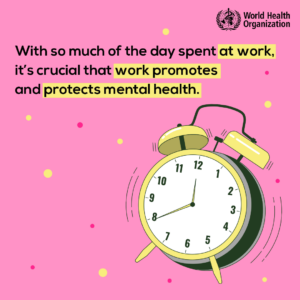Here at the Hogg Foundation, we’re focused on transforming the way communities promote mental health in everyday life, including in the workplace. Likewise, the theme for this year’s World Mental Health Day 2024 is, ‘It is Time to Prioritize Mental Health in the Workplace’.
In this episode, we speak with Dr. Ryan Sutton, associate professor in the department of educational psychology at the University of Texas at Austin and former post-doctoral fellow at the Hogg Foundation, to discuss mental health in the workplace and how workplaces can be transformed into spaces that promote mental health and well-being.
Increased Attention on the Workplace
A reduction in mental health stigma and the post-pandemic return to the workplace have both drawn increased attention to mental health in the workplace. 
“The mental health field has been doing a pretty good job increasing mental health literacy within schools, within communities, within households, and within neighborhoods to ultimately destigmatize mental health,” he says. “I would also say that coming off of the Covid-19 pandemic spurred a lot of this discussion.”
Indeed, the challenges brought on by merging work and home life during the pandemic did not entirely recede in its aftermath.
“As we transitioned back into the office, we had to keep the demands of mental health front and center,” says Ryan. “I think previously, where mental health might have been seen as an individual factor, the pandemic made it an everybody factor, and employers had to recognize this. Going back to the workplace, people still understand mental health is a leading issue that impacts how they show up.”
Workplace Structures and Culture
 Examining the impacts of familiar workplace structures, like scheduling and organizational hierarchy, plays an important role in prioritizing mental health in the workplace.
Examining the impacts of familiar workplace structures, like scheduling and organizational hierarchy, plays an important role in prioritizing mental health in the workplace.
“Inflexible scheduling or inflexible calendaring can make it difficult for people to show up, to be present, to engage in work,” says Ryan. “We know of the many life stressors and issues that impact how and when people get to work. I think what we saw through Covid, was that people were able to have a little bit more control of their schedule.”
Inflexibility in hierarchical working relationships can also impact personal well-being.
“While it’s important to understand who reports to who, it’s also important to understand that power imbalances can strain interpersonal relationships,” says Ryan. “There’s a need for structures like scheduling and hierarchy to be there. But depending on how we manifest them in real time, they can impact mental health one way or the other.”
Organizational culture that inhibits open communication contributes to the stigmatization of mental health in the workplace as well.
“Not really permitting people to bring themselves, their full selves, into the workplace is stressful,” says Ryan. “We end up engaging in activities or behaviors that look like identity covering, covering aspects of our identity that we think we might get judged on or have punitive nature taken out on us. That takes a lot of cognitive and emotional energy to try to show up in a way that masks certain aspects of your identity while still engaging and being present.”
“Presentee-ism”
Facing challenges to mental health in the workplace influences well-being in many ways, including emotionally, cognitively, behaviorally, and even physiologically.
physiologically.
“Emotionally, people may start to feel overwhelmed with sadness or worry or fear, easily angered or easily annoyed. Then you mix that with cognitive symptoms, and you have trouble focusing, you have trouble with your memory, you have trouble concentrating, you become indecisive,” says Ryan. “I think behaviorally, we’ll start to see individuals who don’t show up to work, maybe sleeping quite often and still fatigued or having difficulty sleeping at night. We bring these issues home with us. It impacts our eating. And then lastly, physiologically, I think we carry stress within our bodies. Some of us have become so used to walking around stressed that it’s become normalized for us. So, our shoulders are high and tense, we have back pain and shoulder pain and neck pain. We’re walking around with clenched teeth, or our feet pressed against the floor.”
Indeed, according to the World Health Organization, the global economy loses approximately $1 trillion per year to “presentee-ism”, the health-related loss of productivity at paid work.
Shared Responsibility
 To address these struggles and effect positive change in the workplace, strategies for support are needed at all levels– individual, departmental, and organizational.
To address these struggles and effect positive change in the workplace, strategies for support are needed at all levels– individual, departmental, and organizational.
“We have a responsibility, no matter what level we operate at, to increase mental health in the workplace. And that might be coming from being in a position of power to create organizational change, or being in a management position, where you have the power to model for your employees or your team, or being an employee within the organization, where your interpersonal engagements with other people can come from a place of humanizing, mindful behavior,” says Ryan. “At the end of the day, if we don’t recognize our role and the places that we have within this conversation, then I think the conversation stalls out and we find ourselves at the same point where we are today in the next one, five, or ten years. What we want to do is advance the ball down the field.”
Related Links
- Workplace Mental Health: How to Prioritize Well-being on World Mental Health Day 2024
- Moore Fellowship Winner: Women Knowledge Workers in Higher Education Show Themselves Out
- 3 Things to Know: Allostatic Load
